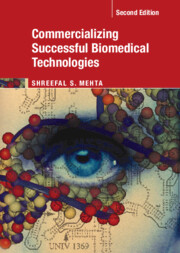Book contents
- Commercializing Successful Biomedical Technologies
- Commercializing Successful Biomedical Technologies
- Copyright page
- Dedication
- Contents
- Preface
- Acknowledgments
- 1 The biomedical device and drug industry and their markets
- 2 Markets of interest and market research steps
- 3 Starting up your company
- 4 Intellectual property and licensing
- 5 New product development (NPD)
- 6 The regulated market: gateway through the FDA
- 7 Manufacturing
- 8 Reimbursement, marketing, sales, and product liability
- Glossary
- Index
- References
4 - Intellectual property and licensing
Published online by Cambridge University Press: 03 November 2022
- Commercializing Successful Biomedical Technologies
- Commercializing Successful Biomedical Technologies
- Copyright page
- Dedication
- Contents
- Preface
- Acknowledgments
- 1 The biomedical device and drug industry and their markets
- 2 Markets of interest and market research steps
- 3 Starting up your company
- 4 Intellectual property and licensing
- 5 New product development (NPD)
- 6 The regulated market: gateway through the FDA
- 7 Manufacturing
- 8 Reimbursement, marketing, sales, and product liability
- Glossary
- Index
- References
Summary
How do you read a patent and what subject matter is patentable? What is the purpose of a patent? Who is an inventor on the patent if work is done by many people on the project? What is the process of obtaining a patent in my country and globally? Read this chapter to see how you could lose commercialization rights to your own invention. When exactly does an invention or idea become patentable? Once you own a patent, how can you make money from it? What is the process of licensing and the key terms that should be negotiated in such a license agreement? What is the use of a copyright or a trade secret in biotech? What exactly constitutes patent infringement ? These questions and many others are addressed in this chapter on intellectual property.
Keywords
Information
- Type
- Chapter
- Information
- Commercializing Successful Biomedical Technologies , pp. 122 - 162Publisher: Cambridge University PressPrint publication year: 2022
